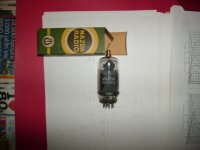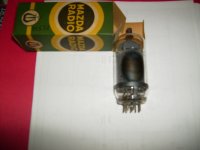Just a quick question..
What was the graphite ring (looked like aquadag..a line that went around the tube base about half an inch up the bottle) that was put on the outside of glass on some sweep tubes for?
I have seen them arc across it..I can't find any pictures and I am sure it was connected to one of the pins on the bottom of the tube..
Curiostiy has the beter of me again
I think this is close:
http://www.google.co.uk/imgres?q=pl...41&tbnw=59&start=0&ndsp=35&ved=1t:429,r:9,s:0
Regards
M. Gregg
What was the graphite ring (looked like aquadag..a line that went around the tube base about half an inch up the bottle) that was put on the outside of glass on some sweep tubes for?
I have seen them arc across it..I can't find any pictures and I am sure it was connected to one of the pins on the bottom of the tube..
Curiostiy has the beter of me again
I think this is close:
http://www.google.co.uk/imgres?q=pl...41&tbnw=59&start=0&ndsp=35&ved=1t:429,r:9,s:0
Regards
M. Gregg
Last edited:
When a high voltage is placed on the anode the glass insite will be charged.
The other pins of the bottom in the tube will "see" that charge and a very small current wil flow. This current can reach the G1 and the cathode. Now your settings are not correct anymore.
This ring is a barrier for this effect.
The other pins of the bottom in the tube will "see" that charge and a very small current wil flow. This current can reach the G1 and the cathode. Now your settings are not correct anymore.
This ring is a barrier for this effect.
When a high voltage is placed on the anode the glass insite will be charged.
The other pins of the bottom in the tube will "see" that charge and a very small current wil flow. This current can reach the G1 and the cathode. Now your settings are not correct anymore.
This ring is a barrier for this effect.
Thanks missisippi!!!
mississippi, I don't quite understand the dc aspect you are referring to?
The characteristic of a sweep application that stands out from the crowd is the short high voltage flyback transient - which to my mind would be the reason for extra shielding, rather than the high duty cycle low voltage conduction period (which is perhaps the DC aspect you are referring to?)
Ciao, Tim
The characteristic of a sweep application that stands out from the crowd is the short high voltage flyback transient - which to my mind would be the reason for extra shielding, rather than the high duty cycle low voltage conduction period (which is perhaps the DC aspect you are referring to?)
Ciao, Tim
Barkhausen oscillation or BK as we called it, manifested itself on some Televisions as a thin vertical stripe of white dots. We used to wrap a single shorted turn of tinned copper wire on the outside of the sweep output tube, take the loop down to a ground point, then adjust the wire loop up and down the tube for minimum interference. Later tubes came with the graphite ring already located inside it as it was becoming a common problem in its day with certain makes of Televisions. I doubt if BK would be a problem with normal audio usage though.
My understanding of BK is it's due to electrode construction; early sweeps, when the plate voltage pulls down below the screen, effectively created a backward wave oscillator between cathode current and secondary emission from the plate as it bounces in the plate-to-screen cavity. The suppressor grid plays an important role here, as biasing it moderately destabilizes the situation.
Tim
Tim
mississippi, I don't quite understand the dc aspect you are referring to?
The characteristic of a sweep application that stands out from the crowd is the short high voltage flyback transient - which to my mind would be the reason for extra shielding, rather than the high duty cycle low voltage conduction period (which is perhaps the DC aspect you are referring to?)
Ciao, Tim
The DC voltage on the plate, will charge the glas bulb. This charge will affect
the the other grids whose wires are at the bottum of the bulb.
I still don't understand - sorry. Are we talking about a constant segragation of molecules/atoms in the air to give a net polarised charge on the outside surface of the glass due to a DC voltage field.
It seems to me the supression of BK is about providing an extra grid element, such that it disturbs the conditions for UHF oscillation.
It seems to me the supression of BK is about providing an extra grid element, such that it disturbs the conditions for UHF oscillation.
Just for interest,
I have seen under fault conditions the ring glow "burn" with a blue dot that spread "moved" across the surface of the ring...I am talking on the outside of the glass.. leaving a burn trace mark..
Again I don't know what caused it..just the point was that conduction was taking place at that point..maybe it was some deposit causing a connection to another pin or maybe it was induced... Then again when the tube was changed the effect happened on the replaced one...(circuit condition /fault maybe?) The duff tube worked in another set..
Regards
M. Gregg
I have seen under fault conditions the ring glow "burn" with a blue dot that spread "moved" across the surface of the ring...I am talking on the outside of the glass.. leaving a burn trace mark..
Again I don't know what caused it..just the point was that conduction was taking place at that point..maybe it was some deposit causing a connection to another pin or maybe it was induced... Then again when the tube was changed the effect happened on the replaced one...(circuit condition /fault maybe?) The duff tube worked in another set..
Regards
M. Gregg
Last edited:
mississipi, maybe this link relates to your comment
Blue Glow In Tubes
If so, then improvements in vacuum level, parts selection, and outgassing parts prior to assembly probably led to alleviating the issue and hence the need to coat the inside surface of the bulb.
Blue Glow In Tubes
If so, then improvements in vacuum level, parts selection, and outgassing parts prior to assembly probably led to alleviating the issue and hence the need to coat the inside surface of the bulb.
mississipi, maybe this link relates to your comment
Blue Glow In Tubes
If so, then improvements in vacuum level, parts selection, and outgassing parts prior to assembly probably led to alleviating the issue and hence the need to coat the inside surface of the bulb.
Yes this is what I mean.
Regards
Graphite ring on sweep tubes is always on the outside of the glass envelope.
And it is usually not connected to anything.
Examples:
PL509 @ The National Valve Museum
exhibits of same type designation
Only tubes with plate cap seem to have it.
PL508 @ The National Valve Museum
And it is usually not connected to anything.
Examples:
PL509 @ The National Valve Museum
exhibits of same type designation
Only tubes with plate cap seem to have it.
PL508 @ The National Valve Museum
when television was brought into existence, there was a lot of safety precautions that were not in place. the 2nd anode was exposed. etc. in the 50's x-ray radiation paranoia was high and the total auquadag coating of the crt was introduced, and the shadow mask (one of several advantages of the shadow mask).
the "Barkhausen effect" was more of a tripler tube and yolk resonance thing that capacitor network fixed.
the ring was a safety precaution that was on some sweep tubes because when those tubes failed cause a tremendous release of x-radiation. they were either grounded or though a spark cap. some sweep tube had them on them to alter the inter-electrode capacitance to lower grid emission.
the "Barkhausen effect" was more of a tripler tube and yolk resonance thing that capacitor network fixed.
the ring was a safety precaution that was on some sweep tubes because when those tubes failed cause a tremendous release of x-radiation. they were either grounded or though a spark cap. some sweep tube had them on them to alter the inter-electrode capacitance to lower grid emission.
Some history
X-rays emanate at an angle from the rear of the target, so little would out of the front of the CRT.
Aquadag was there to produce a capacitor to smooth the final anode voltage.
Protection from CRT generated X-rays was achieved mainly by lead-loaded glass.
X-radiation only occurs at voltages exceeding 25KV, thus it wasn't a problem until colour TV came along, except for projection TV's.
The major X-ray generator in valve TV's was the shunt regulator (European type eg PD500) which was always screened.
I have never heard of X-ray emanation from a "sweep tube". Please explain the mechanism.
X-rays emanate at an angle from the rear of the target, so little would out of the front of the CRT.
Aquadag was there to produce a capacitor to smooth the final anode voltage.
Protection from CRT generated X-rays was achieved mainly by lead-loaded glass.
X-radiation only occurs at voltages exceeding 25KV, thus it wasn't a problem until colour TV came along, except for projection TV's.
The major X-ray generator in valve TV's was the shunt regulator (European type eg PD500) which was always screened.
I have never heard of X-ray emanation from a "sweep tube". Please explain the mechanism.
- Status
- This old topic is closed. If you want to reopen this topic, contact a moderator using the "Report Post" button.
- Home
- Amplifiers
- Tubes / Valves
- Graphite ring on sweep tubes

